From the Clifton side of the Bridge it's a short walk up to the Observatory, but on the way there is a very unusual feature to be seen - the Rock Slide.
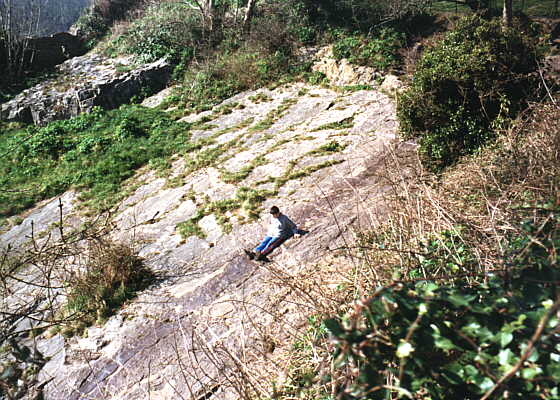
The Rock Slide
Generations of children's bums have worn this piece of rock to glassy smoothness, ideal for whizzing down the 30ft odd feet slab of rock.
Passing this we come to the Observatory. This was originally built as a Snuff Mill, the windmill was destroyed by fire in 1777, but was rebuilt in 1829 by a Mr West who installed the Camera Obscura. Today, after many years of neglect, it's an interesting place to visit.
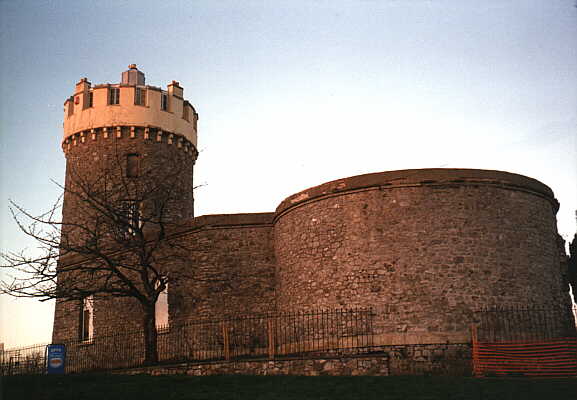
The Observatory
In the tower there is a Camera Obscura. This is an arrangement of mirrors and lenses that projects an image onto a circular table. By turning a handle different parts of the city can be bought into view, giving a 360-degree, panoramic view. The circular part of the building houses the entrance to the Giant's Cave. This is a passageway that leads to an opening in the face of the gorge. A metal grating lets you walk out a couple of feet into the gorge which can be very disconcerting.
Charles Fredrick Cliff in his 1854 The Book of South Wales, the Bristol Channel, Monmouthshire, and the Wye, page 20, describes how Mr. West gained access to the cave which was once a hermitage:
Previously to 1830, the only apparent means of gaining access to this cave was by a narrow ledge of rock a few feet below the entrance, of fearfully dangerous character, which was removed to prevent accidents.
A few hardy spirits, however, still succeeded in the hazardous enterprise; when in 1835 Mr. West, the proprietor of the Observatory above, conceived the idea of blasting a passage from that structure to it. A shaft, with steps, was sunk for 35 feet; then a passage was driven down an incline for 150 feet; and finally another flight of steps, 30 feet deep, carried to the eastern end of the cave, which was protected by an iron
railing.
The floor of the cave was covered with earth and decomposed vegetable matter, in some places to a depth of three feet. Below this was a layer of stalagmite, but no bones were found. In the cavern were numerous fragments of pottery, supposed by some to be Roman; a square glazed tile, like those used in churches; and a portion of a mullion of a small gothic window, or probably of a tabernacle or shrine. These relics were imbedded under a large flat stone covered with rubbish.
The cave is 88 feet from the summit of the rock, and 220 feet from high-water mark, which show that St. Vincent's Rocks rise 308 feet. Its entrance is arudely arched portal, 10 feet high and 13 broad; the roof expands to a height of 18 feet; and there are several cavities, the end of
one of which is 49 feet from the entrance.
The following images nicely show the cave and surrounding area:
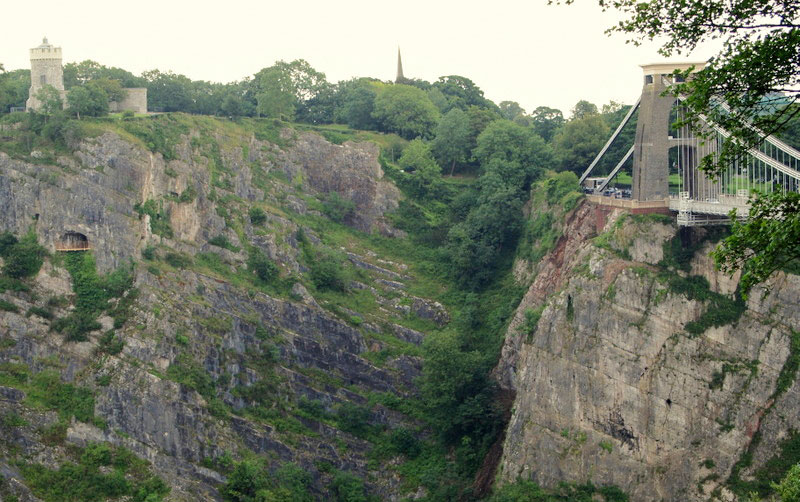
St. Vincent's Rock in 2012. Photo by David Hallam-Jones. Downloaded from Geograph 3096166. (CC BY-SA 2.0)
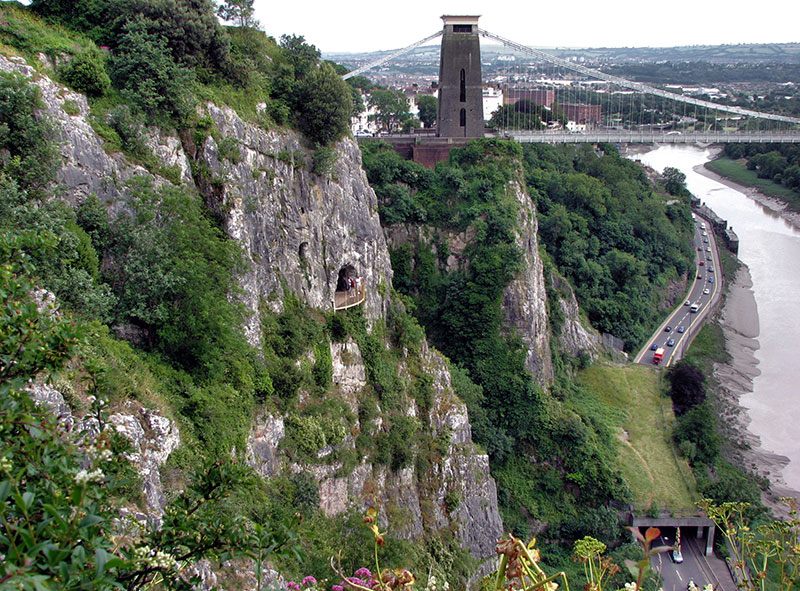
Avon gorge and Cave in 2006. Photo by Adrian Pingstone. Downloaded from Wikimedia Commons. (Public Domain)
Cliff goes on to say that:
A large cavern 50 feet deep was found on St. Vincent's Rocks by the workmen employed in excavating a roadway for the suspension bridge; and a most interesting Bone Cavern has also been accidently discovered on Durdham Down, by men employed in a quarry. Bones of the elephant, rhinoceros,
hippopotamus, hyena, bear, &c., were amongst the osseous remains, and may be seen in the Bristol Institution.
John Dix (September 21, 1811 – after 1863) was a writer, bad poet, worse surgeon and alcoholic. His work appeared in the Bristol Mirror. In 1839, he wrote a collection of poems published as Local legends and Rambling Rhymes, with illustrations by "A. Pen". In that, is this:
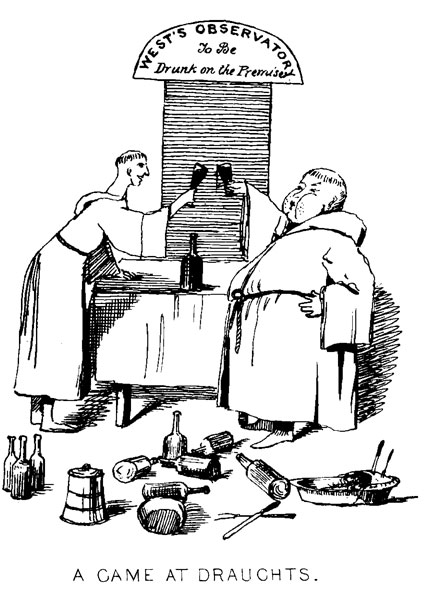 St. Vick
St. Vick
Of all the hermits that ever were known
To live in holes, or He upon stone,
Scorning the comforts of feather and tick,
(Including Saints Bernard and Benedict,)
None were so great as the great St. Vick!
By night and by day,
He'd devoutly pray;
The morn's dim dawn and the eve's last ray,
Beheld him kneeling, true as the clock,
In his snug little hole, in St. Vincent's rock.
One pleasant morning in spring, St. Vick
Having nothing to do,
And inclined to shew
His respect for St. Vincent, grasp'd his stick;
Round a slippery ledge,
Which skirted the edge
Of the rock, with footsteps tottering and faint,
He went to visit his brother saint.
He knocked at his gate with a feeble rap,
'Twas open'd, but strait with a terrible clap
It clos'd, and St. Vick was turning round,
When he heard from above a chuckling sound;
And a rosy old chap,
Just awoke from his nap
By the noise, halloo'd out—"Here's a capital trick,
To turn from the gate my old friend, St. Vick!
My jolly old porter below, I suppose,
Mistook for a beggar's your water-cress nose."
'Tis six by the sun!
The breakfast's begun,
And old St. Vincent is full of his fun;
He slaps his lean friend on the small of his back,
And drinks to the church in a bumper of sack!
I ween 'twas a goodly sight to see,
That pair in Saint Vincent's priorie!
Flagons of ale, and capons fat,
Crowded the board where the churchmen sat!
They ate and they quaff'd,
They sung and they laugh'd,
Until Vick, who'd got more than his head was able
To bear, roll'd under the great oak table.
Repentant and sick,
Sat poor St. Vick,
On a sharp bit of rock, his conscience to prick!
How he got back to his lonely cell,
It puzzled the anchorite's wits to tell!
He pray'd to the Virgin, and counted o'er
His beads a thousand times or more;
And he vow'd that never again his lip,
Other than water pure should sip!
For the future, he
Liv'd holily
In his hole; and often at deep midnight
Was seen the anchorite's lamp alight,
Gleaming within the cave's recess,
When he was preparing a work for the press;
Sat he there in the cave alone,
Hearing nought but the night-owl's moan.
From the dim woods ; or the seagull's scream,
As it's wing glanc'd in the white moonbeam.
Long years pass'd by—
The hermit's eye
Had clos'd for ever in death, and his frame
Had return'd to the dust from whence it came;
When with powder and spade,
A passage was made
Through the rock, by which the curious survey'd
The hermit's cell,
Where, strange to tell,
As if preserved by a miracle,
Were found some parchments, mouldy and damp,
Beside the remains of an inkstand and lamp;
On one was written, in letters thick,
"This is the Will of me, St. Vick
The other papers we shall transfer
To a noted London publisher;
Only noting this one, among the rest,
Pick'd up in the cavern by Mr. West.
"I give and bequeath,
After my death,
To earth my bones, and to heaven my soul;
And happy may be the old man's dole!
I give, of this hole, which I've long possest,
The sole right of entrance to William West!
And for being protected, when drunk on the ridge
Of the rock, I desire that a mighty bridge
May be built, to perpetuate my fame,
By one who hereafter shall bear my name;
That after ages may wond'ringly tell—
This was strange enough—but 'tis stranger still,
That one Mr. Vick should leave by his will,
In after years, a sum for a bridge
To span the rocks, from ridge to ridge;
And that Mr. West, (vide will), should be willing,
To show the anchorite's cave for a shilling!
The Mr. Vick mentioned in the poem was Bristol mechant William Vick. In 1753, he left a bequest in his will of £1,000 (equivalent to £140,000 in 2015), invested with instructions that when the interest had accumulated to £10,000 (£1,370,000), it should be used for the purpose of building a stone bridge between Clifton Down (which was in Gloucestershire, outside the City of Bristol, until the 1830s) and Leigh Woods in Somerset. The money was used for the Clifton Suspension Bridge. Incidentally, in 1832, Dix married Sussanah Moore whose father boiled soap in Bedminster.
The Observatory stands on the edge of the Downs. This is 180 hectares (422 acres) of park and woodland that sits on top of the gorge. Originally belonging to the Manor of Clifton the land was purchased by the Merchant Venturers in the seventeenth century. In 1861 it was preserved by an Act of Parliament as an open space for the use of the inhabitants of Bristol, forever. Sheep were grazed here until 1924, the owner of the Clifton Down Hotel even complained that the noise of the sheep disturbed his guests.
Near the Observatory are the remains of a little known engineering feat. The Temple Meads to Severn Beach railway runs under the Downs in Clifton Down tunnel which was opened in 1877 to goods traffic and on 1st September 1885. The tunnel is 1,751yards (just under a mile) long and still in use. One of the ventilation tunnels can be seen in the extreme South West corner of the Downs. more pictures and information of the tunnel can be found at The Bristol Railway Archive site. My thanks to Dr. Martin Adams for pointing out the line is still in use when I originally said that it had been abandoned.
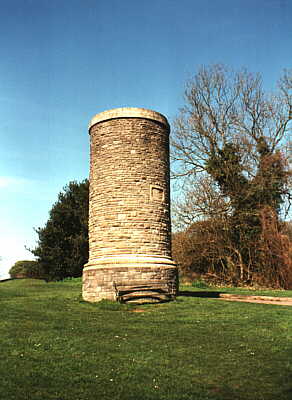
The railway ventilation tower
Around the ventilation tower are patches of very uneven ground, known as the Dumps, this is all that remains of very old quarrying and lead workings. Running across the Downs is Ladies Mile Road, originally named because this was a route used by well-do-to ladies out riding, it later became the haunt of prostitutes.
This page created July 26, 2004; last modified October 29, 2022




 St. Vick
St. Vick